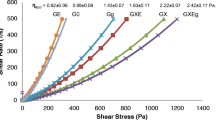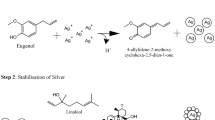Abstract
In this study, we produced hydroxypropyl methylcellulose (HPMC) films containing silver nanoparticles (AgNPs) by a straightforward method for potential wound dressing applications. Polyvinylpyrrolidone (PVP) or polyvinyl alcohol (PVA) was added to these films to improve their mechanical properties. Various compositions of HPMC, PVP/PVA, and AgNPs were tested. The films containing AgNPs exhibited a yellow color, and the confirmation of silver nanoparticles was achieved through UV–Vis analysis. The antimicrobial capacity of HPMC films was assessed against strains of Staphylococcus aureus, Escherichia coli, Pseudomonas aeruginosa, and Candida albicans. Pristine HPMC and HPMC films blended with PVA/PVP displayed no antimicrobial activity, emphasizing the essential role of silver nanoparticles. The films with the highest AgNP content effectively inhibited Escherichia coli, Pseudomonas aeruginosa, and Staphylococcus aureus, surpassing the literature data. Some samples showed moderate inhibitory activity against Candida albicans. These films show potential as wound dressings, attributed to their antimicrobial properties and their convenient removal in the shower or by using a gentle water spray which may lead to reduced discomfort compared to traditional dressings. Further research is required to assess their clinical performance.








Similar content being viewed by others
References
Mohammed T, Risan MH, Kadhom M, Raheem R, Yousif E (2020) Antifungal, antiviral, and antibacterial activities of silver nanoparticles synthesized using fungi: a review. Lett Appl NanoBioSci 9:1307–1312. https://doi.org/10.33263/LIANBS93.13071312
Le Ouay B, Stellacci F (2015) Antibacterial activity of silver nanoparticles: a surface science insight. Nano Today 10:339–354. https://doi.org/10.1016/j.nantod.2015.04.002
Dong Q, Zu D, Kong L et al (2022) Construction of antibacterial nano-silver embedded bioactive hydrogel to repair infectious skin defects. Biomater Res 26:36. https://doi.org/10.1186/s40824-022-00281-7
Li SQ, Dong SJ, Xu WG et al (2018) Antibacterial hydrogels. Adv Sci. https://doi.org/10.1002/advs.201700527
Portela R, Leal CR, Almeida PL, Sobral RG (2019) Bacterial cellulose: a versatile biopolymer for wound dressing applications. Microb Biotechnol 12:586–610. https://doi.org/10.1111/1751-7915.13392
Maneerung T, Tokura S, Rujiravanit R (2008) Impregnation of silver nanoparticles into bacterial cellulose for antimicrobial wound dressing. Carbohydr Polym 72:43–51. https://doi.org/10.1016/j.carbpol.2007.07.025
Agnihotri S, Mukherji S, Mukherji S (2013) Immobilized silver nanoparticles enhance contact killing and show highest efficacy: elucidation of the mechanism of bactericidal action of silver. Nanoscale 5:7328. https://doi.org/10.1039/c3nr00024a
Wang J-X, Wen L-X, Wang Z-H, Chen J-F (2006) Immobilization of silver on hollow silica nanospheres and nanotubes and their antibacterial effects. Mater Chem Phys 96:90–97. https://doi.org/10.1016/j.matchemphys.2005.06.045
Garcia AM, Martins TS, Camilo FF (2021) Free facile preparation of Ag-nanoparticles on cellulose membrane for catalysis. Cellulose 28:4899–4911. https://doi.org/10.1007/s10570-021-03827-5
Fahs A, Brogly M, Bistac S, Schmitt M (2010) Hydroxypropyl methylcellulose (HPMC) formulated films: relevance to adhesion and friction surface properties. Carbohydr Polym 80:105–114. https://doi.org/10.1016/j.carbpol.2009.10.071
Klangmuang P, Sothornvit R (2016) Barrier properties, mechanical properties and antimicrobial activity of hydroxypropyl methylcellulose-based nanocomposite films incorporated with Thai essential oils. Food Hydrocoll 61:609–616. https://doi.org/10.1016/j.foodhyd.2016.06.018
Otoni CG, Lorevice MV, de Moura MR, Mattoso LHC (2018) On the effects of hydroxyl substitution degree and molecular weight on mechanical and water barrier properties of hydroxypropyl methylcellulose films. Carbohydr Polym 185:105–111. https://doi.org/10.1016/j.carbpol.2018.01.016
Romão S, Bettencourt A, Ribeiro IAC (2022) Novel features of cellulose-based films as sustainable alternatives for food packaging. Polymers (Basel) 14:4968. https://doi.org/10.3390/polym14224968
Cavalheiro Maeda V, Correa CM, Mamoru Otsuka Hamanaka MH et al (2023) Electrical and mechanical properties of self-supported hydroxypropyl methylcellulose–polyaniline conducting films. RSC Adv 13:7913–7920. https://doi.org/10.1039/d3ra00916e
Ndlovu SP, Fonkui TY, Ndinteh DT, Aderibigbe BA (2022) Dissolvable wound dressing loaded with silver nanoparticles together with ampicillin and ciprofloxacin. Ther Deliv 13:295–311. https://doi.org/10.4155/tde-2021-0087
Jayaramudu T, Varaprasad K, Pyarasani RD et al (2021) Hydroxypropyl methylcellulose-copper nanoparticle and its nanocomposite hydrogel films for antibacterial application. Carbohydr Polym 254:117302. https://doi.org/10.1016/j.carbpol.2020.117302
De Moura MR, Mattoso LHC, Zucolotto V (2012) Development of cellulose-based bactericidal nanocomposites containing silver nanoparticles and their use as active food packaging. J Food Eng 109:520–524. https://doi.org/10.1016/j.jfoodeng.2011.10.030
George J, Kumar R, Sajeevkumar VA et al (2014) Hybrid HPMC nanocomposites containing bacterial cellulose nanocrystals and silver nanoparticles. Carbohydr Polym 105:285–292. https://doi.org/10.1016/j.carbpol.2014.01.057
Filimon A, Onofrei MD, Bargan A et al (2023) Bioactive materials based on hydroxypropyl methylcellulose and silver nanoparticles: structural-morphological characterization and antimicrobial testing. Polymers (Basel) 15:1625. https://doi.org/10.3390/polym15071625
Masson JF, John Manley RS (1991) Miscible blends of cellulose and poly(vinylpyrrolidone). Macromolecules 24:6670–6679. https://doi.org/10.1021/ma00025a018
Guirguis OW, Moselhey MTH (2011) Optical study of poly(vinyl alcohol)/hydroxypropyl methylcellulose blends. J Mater Sci 46:5775–5789. https://doi.org/10.1007/s10853-011-5533-5
Mulfinger L, Solomon SD, Bahadory M et al (2007) Synthesis and study of silver nanoparticles. J Chem Educ 84:322. https://doi.org/10.1021/ed084p322
Lima GAS, Guerini GG, de Vasconcellos SP, Pellosi DS (2023) Visible light-induced synergic antimicrobial activity of silver nanoparticles/methylene blue nanohybrids encapsulated in chitosan and pluronic polymers. Chem Pap 77:549–561. https://doi.org/10.1007/s11696-022-02509-1
Youssef AM, El-Sayed SM (2018) Bionanocomposites materials for food packaging applications: concepts and future outlook. Carbohydr Polym 193:19–27. https://doi.org/10.1016/j.carbpol.2018.03.088
Shahbazi M, Rajabzadeh G, Rafe A et al (2016) The physico-mechanical and structural characteristics of blend film of poly (vinyl alcohol) with biodegradable polymers as affected by disorder-to-order conformational transition. Food Hydrocoll 60:393–404. https://doi.org/10.1016/j.foodhyd.2016.03.038
Song T, Tanpichai S, Oksman K (2016) Cross-linked polyvinyl alcohol (PVA) foams reinforced with cellulose nanocrystals (CNCs). Cellulose 23:1925–1938. https://doi.org/10.1007/s10570-016-0925-y
Huang S, Zhou L, Li M-C et al (2016) Preparation and properties of electrospun poly (vinyl pyrrolidone)/cellulose nanocrystal/silver nanoparticle composite fibers. Materials 9:523. https://doi.org/10.3390/ma9070523
Hussin H, Gan SN, Mohamad S, Phang SW (2017) Synthesis of water-soluble polyaniline by using different types of cellulose derivatives. Polym Polym Compos 25:515–520. https://doi.org/10.1177/096739111702500702
Chen Y, Cao X, Chang PR, Huneault MA (2008) Comparative study on the films of poly(vinyl alcohol)/pea starch nanocrystals and poly(vinyl alcohol)/native pea starch. Carbohydr Polym 73:8–17. https://doi.org/10.1016/j.carbpol.2007.10.015
Wiśniewska M, Chibowski S, Urban T, Sternik D (2011) Investigation of the alumina properties with adsorbed polyvinyl alcohol. J Therm Anal Calorim 103:329–337. https://doi.org/10.1007/s10973-010-1040-1
Lee KC, Lin SJ, Lin CH et al (2008) Size effect of Ag nanoparticles on surface plasmon resonance. Surf Coat Technol 202:5339–5342. https://doi.org/10.1016/j.surfcoat.2008.06.080
Jain PK, Huang X, El-Sayed IH, El-Sayed MA (2007) Review of some interesting surface plasmon resonance-enhanced properties of noble metal nanoparticles and their applications to biosystems. Plasmonics 2:107–118. https://doi.org/10.1007/s11468-007-9031-1
Ranadive P, Parulkar A, Brunelli NA (2019) Jet-mixing reactor for the production of monodisperse silver nanoparticles using a reduced amount of capping agent. React Chem Eng 4:1779–1789. https://doi.org/10.1039/c9re00152b
Luu QN, Doorn JM, Berry MT et al (2011) Preparation and optical properties of silver nanowires and silver-nanowire thin films. J Colloid Interface Sci 356:151–158. https://doi.org/10.1016/j.jcis.2010.12.077
Zaccaron CM, Oliveira RVB, Guiotoku M et al (2005) Blends of hydroxypropyl methylcellulose and poly(1-vinylpyrrolidone-co-vinyl acetate): miscibility and thermal stability. Polym Degrad Stab 90:21–27. https://doi.org/10.1016/j.polymdegradstab.2005.02.010
Chrissafis K, Paraskevopoulos KM, Tsiaoussis I, Bikiaris D (2009) Comparative study of the effect of different nanoparticles on the mechanical properties, permeability, and thermal degradation mechanism of HDPE. J Appl Polym Sci 114:1606–1618. https://doi.org/10.1002/app.30750
Farha AH, Al Naim AF, Mansour SA (2020) Thermal degradation of polystyrene (PS) nanocomposites loaded with sol gel-synthesized ZnO nanorods. Polymers (Basel) 12:1935. https://doi.org/10.3390/polym12091935
Sánchez-González L, Vargas M, González-Martínez C et al (2009) Characterization of edible films based on hydroxypropylmethylcellulose and tea tree essential oil. Food Hydrocoll 23:2102–2109. https://doi.org/10.1016/j.foodhyd.2009.05.006
Fernandes EM, Mano JF, Reis RL (2013) Hybrid cork–polymer composites containing sisal fibre: morphology, effect of the fibre treatment on the mechanical properties and tensile failure prediction. Compos Struct 105:153–162. https://doi.org/10.1016/j.compstruct.2013.05.012
Ko Y-B, Park Y-H, MubarakAli D et al (2023) Synthesis of antibacterial hydroxypropyl methylcellulose and silver nanoparticle biocomposites via solution plasma using silver electrodes. Carbohydr Polym 302:120341. https://doi.org/10.1016/j.carbpol.2022.120341
Acknowledgments
Larissa Verena F. de Oliveira gratefully acknowledges the financial support from The São Paulo Research Foundation (FAPESP) (Grant Number: 2021/07971-8). Fernanda F. Camilo gratefully acknowledges the financial support from FAPESP (Grant Number: 2021/08987-5) and CNPq scientific productivity fellowship (Grant Number: 310893/2021-6).
Author information
Authors and Affiliations
Corresponding authors
Ethics declarations
Conflict of interest
The authors declare that they have no known competing financial interests or personal relationships that could have appeared to influence the work reported in this paper.
Additional information
Publisher's Note
Springer Nature remains neutral with regard to jurisdictional claims in published maps and institutional affiliations.
Supplementary Information
Below is the link to the electronic supplementary material.
Rights and permissions
Springer Nature or its licensor (e.g. a society or other partner) holds exclusive rights to this article under a publishing agreement with the author(s) or other rightsholder(s); author self-archiving of the accepted manuscript version of this article is solely governed by the terms of such publishing agreement and applicable law.
About this article
Cite this article
Barroso, B.L., Garcia, A.M., Molina, C. et al. Enhanced mechanical and antimicrobial properties of hydroxypropyl methylcellulose films incorporating silver nanoparticles for wound dressing applications. Polym. Bull. (2024). https://doi.org/10.1007/s00289-024-05217-w
Received:
Revised:
Accepted:
Published:
DOI: https://doi.org/10.1007/s00289-024-05217-w




